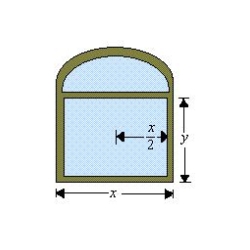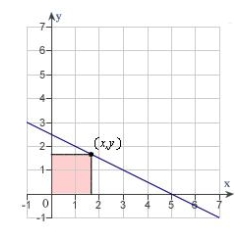Deck 4: Section 7: Applications of Differentiation
Question
Question
Question
Question
Question
Question
Question
Question
Question
Question
Question
Question
Question
Question
Question

Unlock Deck
Sign up to unlock the cards in this deck!
Unlock Deck
Unlock Deck
1/15
Play
Full screen (f)
Deck 4: Section 7: Applications of Differentiation
1
Find two positive numbers whose product is 181 and whose sum is a minimum.
A)
B)
C)
D)
E)
A)

B)

C)

D)

E)


2
The sum of the perimeters of an equilateral triangle and a square is 19. Find the dimensions of the triangle and the square that produce a minimum total area.
A)
B)
C)
D)
E)
A)

B)

C)

D)

E)


3
Find the length and width of a rectangle that has an area of 968 square feet and whose perimeter is a minimum.
A)
B)
C)
D)
E)
A)

B)

C)

D)

E)


4
Find the length and width of a rectangle that has perimeter  meters and a maximum area.
meters and a maximum area.
A) 12 m; 12 m.
B) 16 m; 9 m.
C) 1m; 23 m.
D) 13 m; 11 m.
E) 6 m; 18 m.
 meters and a maximum area.
meters and a maximum area.A) 12 m; 12 m.
B) 16 m; 9 m.
C) 1m; 23 m.
D) 13 m; 11 m.
E) 6 m; 18 m.

Unlock Deck
Unlock for access to all 15 flashcards in this deck.
Unlock Deck
k this deck
5
Find the point on the graph of the function  that is closest to the point
that is closest to the point  .
.
A)
B)
C)
D)
E)
 that is closest to the point
that is closest to the point  .
.A)

B)

C)

D)

E)


Unlock Deck
Unlock for access to all 15 flashcards in this deck.
Unlock Deck
k this deck
6
Find two positive numbers such that the sum of the first and twice the second is 56 and whose product is a maximum.
A)
B) 28 and 14
C)
D)
E)
A)

B) 28 and 14
C)

D)

E)


Unlock Deck
Unlock for access to all 15 flashcards in this deck.
Unlock Deck
k this deck
7
A Norman window is constructed by adjoining a semicircle to the top of an ordinary rectangular window (see figure). Find the dimensions of a Norman window of maximum area if the total perimeter is 38 feet. 
A)
B)
C)
D)
E)

A)

B)

C)

D)

E)


Unlock Deck
Unlock for access to all 15 flashcards in this deck.
Unlock Deck
k this deck
8
A solid is formed by adjoining two hemispheres to the ends of a right circular cylinder. The total volume of the solid is 30 cubic centimeters. Find the radius, r, of the cylinder that produces the minimum surface area. Round your answer to two decimal places.
A)
B)
C)
D)
E)
A)

B)

C)

D)

E)


Unlock Deck
Unlock for access to all 15 flashcards in this deck.
Unlock Deck
k this deck
9
A rectangle is bounded by the x- and y-axes and the graph of  (see figure). What length and width should the rectangle have so that its area is a maximum?
(see figure). What length and width should the rectangle have so that its area is a maximum? 
A)
B)
C)
D)
E)
 (see figure). What length and width should the rectangle have so that its area is a maximum?
(see figure). What length and width should the rectangle have so that its area is a maximum? 
A)

B)

C)

D)

E)


Unlock Deck
Unlock for access to all 15 flashcards in this deck.
Unlock Deck
k this deck
10
A sector with central angle  is cut from a circle of radius 10 inches, and the edges of the sector are brought together to form a cone. Find the magnitude of
is cut from a circle of radius 10 inches, and the edges of the sector are brought together to form a cone. Find the magnitude of  such that the volume of the cone is a maximum.
such that the volume of the cone is a maximum.
A)
B)
C)
D)
E)
 is cut from a circle of radius 10 inches, and the edges of the sector are brought together to form a cone. Find the magnitude of
is cut from a circle of radius 10 inches, and the edges of the sector are brought together to form a cone. Find the magnitude of  such that the volume of the cone is a maximum.
such that the volume of the cone is a maximum.A)

B)

C)

D)

E)


Unlock Deck
Unlock for access to all 15 flashcards in this deck.
Unlock Deck
k this deck
11
Assume that the amount of money deposited in a bank is proportional to the square of the interest rate the bank pays on this money. Furthermore, the bank can reinvest this money at 36%. Find the interest rate the bank should pay to maximize profit. (Use the simple interest formula.)
A)
B)
C)
D)
E)
A)

B)

C)

D)

E)


Unlock Deck
Unlock for access to all 15 flashcards in this deck.
Unlock Deck
k this deck
12
Find the point on the graph of the function  that is closest to the point
that is closest to the point  . Round all numerical values in your answer to four decimal places.
. Round all numerical values in your answer to four decimal places.
A)
B)
C)
D)
E)
 that is closest to the point
that is closest to the point  . Round all numerical values in your answer to four decimal places.
. Round all numerical values in your answer to four decimal places.A)

B)

C)

D)

E)


Unlock Deck
Unlock for access to all 15 flashcards in this deck.
Unlock Deck
k this deck
13
On a given day, the flow rate F (cars per hour) on a congested roadway is given by  where v is the speed of the traffic in miles per hour. What speed will maximize the flow rate on the road? Round your answer to the nearest mile per hour.
where v is the speed of the traffic in miles per hour. What speed will maximize the flow rate on the road? Round your answer to the nearest mile per hour.
A) 18 miles per hour
B) 16 miles per hour
C) 17 miles per hour
D) 10 miles per hour
E) 21 miles per hour
 where v is the speed of the traffic in miles per hour. What speed will maximize the flow rate on the road? Round your answer to the nearest mile per hour.
where v is the speed of the traffic in miles per hour. What speed will maximize the flow rate on the road? Round your answer to the nearest mile per hour.A) 18 miles per hour
B) 16 miles per hour
C) 17 miles per hour
D) 10 miles per hour
E) 21 miles per hour

Unlock Deck
Unlock for access to all 15 flashcards in this deck.
Unlock Deck
k this deck
14
A rectangular page is to contain  square inches of print. The margins on each side are 1 inch. Find the dimensions of the page such that the least amount of paper is used.
square inches of print. The margins on each side are 1 inch. Find the dimensions of the page such that the least amount of paper is used.
A)
B)
C)
D)
E)
 square inches of print. The margins on each side are 1 inch. Find the dimensions of the page such that the least amount of paper is used.
square inches of print. The margins on each side are 1 inch. Find the dimensions of the page such that the least amount of paper is used.A)

B)

C)

D)

E)


Unlock Deck
Unlock for access to all 15 flashcards in this deck.
Unlock Deck
k this deck
15
Determine the dimensions of a rectangular solid (with a square base) with maximum volume if its surface area is 529 square meters.
A) Dimensions:
B) Dimensions:
C) Dimensions:
D) Dimensions:
E) Dimensions:
A) Dimensions:

B) Dimensions:

C) Dimensions:

D) Dimensions:

E) Dimensions:


Unlock Deck
Unlock for access to all 15 flashcards in this deck.
Unlock Deck
k this deck



